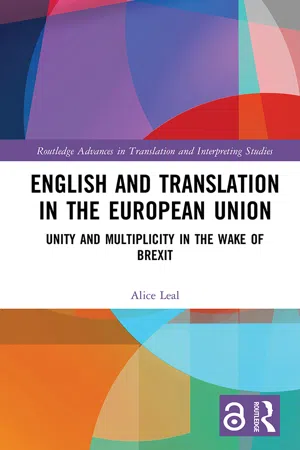
English and Translation in the European Union
Unity and Multiplicity in the Wake of Brexit
- 264 pages
- English
- ePUB (mobile friendly)
- Available on iOS & Android
English and Translation in the European Union
Unity and Multiplicity in the Wake of Brexit
About this book
This book explores the growing tension between multilingualism and monolingualism in the European Union in the wake of Brexit, underpinned by the interplay between the rise of English as a lingua franca and the effacement of translations in EU institutions, bodies and agencies.
English and Translation in the European Union draws on an interdisciplinary approach, highlighting insights from applied linguistics and sociolinguistics, translation studies, philosophy of language and political theory, while also looking at official documents and online resources, most of which are increasingly produced in English and not translated at all – and the ones which are translated into other languages are not labelled as translations. In analysing this data, Alice Leal explores issues around language hierarchy and the growing difficulty in reconciling the EU's approach to promoting multilingualism while fostering monolingualism in practice through the diffusion of English as a lingua franca, as well as questions around authenticity in the translation process and the boundaries between source and target texts. The volume also looks ahead to the implications of Brexit for this tension, while proposing potential ways forward, encapsulated in the language turn, the translation turn and the transcultural turn for the EU.
Offering unique insights into contemporary debates in the humanities, this book will be of interest to scholars in translation studies, applied linguistics and sociolinguistics, philosophy and political theory.
Frequently asked questions
- Essential is ideal for learners and professionals who enjoy exploring a wide range of subjects. Access the Essential Library with 800,000+ trusted titles and best-sellers across business, personal growth, and the humanities. Includes unlimited reading time and Standard Read Aloud voice.
- Complete: Perfect for advanced learners and researchers needing full, unrestricted access. Unlock 1.4M+ books across hundreds of subjects, including academic and specialized titles. The Complete Plan also includes advanced features like Premium Read Aloud and Research Assistant.
Please note we cannot support devices running on iOS 13 and Android 7 or earlier. Learn more about using the app.
Information
1 Language, Meaning and Identity
From Mother Tongue to Lingua Franca
1.1 Introduction
1.2 The Classical Paradigm and Its Legacy: Logos and Affections of the Soul
1.3 A Historical Note on the Rise of Vernaculars: Cuius Regio, Eius Lingua
Table of contents
- Cover
- Half Title
- Series Page
- Title Page
- Copyright Page
- Dedication
- Table of Contents
- List of Illustrations
- Preface and Acknowledgements
- Introduction
- 1. Language, Meaning and Identity: From Mother Tongue to Lingua Franca
- 2. The EU and English as a “Lingua Franca”: De Jure Multilingualism Versus De Facto Monolingualism
- 3. Translation and the EU: The Tension between Unity Versus Multiplicity
- 4. The EU as a Community in Formation in the Wake of Brexit: For a New Linguistic Regime
- 5. The Future of Language and Translation in the EU: The Language Turn, the Translation Turn and the Transcultural Turn
- Final Remarks
- Appendix
- Index